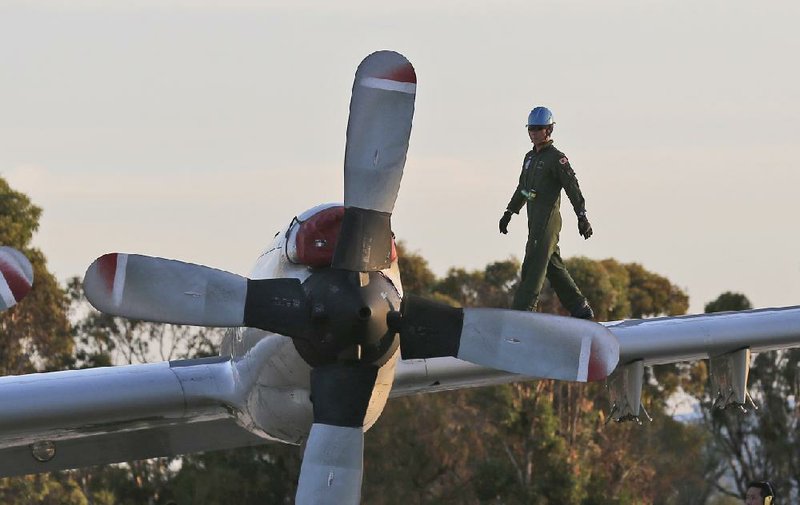PERTH, Australia - Rain was expected to hamper the hunt today for the missing Malaysia Airlines jet, as a growing number of planes focus on an expanded area of the south Indian Ocean where French radar detected potential debris.
Australian Maritime Safety Authority’s rescue coordination center said the search area was expanded from 22,800 square miles to 26,400 square miles today, including a new, separate area covered by data provided by France on Sunday.
Two Chinese Ilyushin IL-76 planes joined the search from Perth today, increasing the number of aircraft from eight Sunday to 10, the safety authority said.
It said the weather in the search area, about 1,550 miles southwest of Perth, was expected to deteriorate with rain likely.
Australian Transport Minister Warren Truss said “nothing of note” was found Sunday, which he described as a “fruitless day.”
“It’s going to be a challenge, but we’ll stick at it,” he told Australian Broadcasting Corp. radio before the first aircraft left Perth at dawn.
He said that the new search area based on French radar data was 530 miles north of the previous search zone. He said it was not the same area that had been identified as the most likely place where the aircraft may have entered the sea, “but … we’ve got to check out all the options.”
“We’re just, I guess, clutching at whatever little piece of information comes along to try and find a place where we might be able to concentrate the efforts,” he added.
A cyclone bearing down on the Australian northwest coast “could stir up less favorable weather,” he said.
Flight 370 vanished March 8 with 239 people aboard while en route from Kuala Lumpur, Malaysia, to Beijing, setting off a multinational search that has turned up no confirmed pieces and nothing conclusive on what happened to the jet.
The latest French satellite data came to light Sunday as Australian authorities coordinating the search sent planes and a ship to try to “re-find” a wooden pallet that appeared to be surrounded by straps of different lengths and colors.
The pallet was spotted Saturday from a search plane, but the spotters were unable to take photos of it, and a PC Orion military plane dispatched to locate it could not find it.
“So, we’ve gone back to that area again today to try and re-find it,” said Mike Barton, chief of the Australian rescue coordination center. “It’s a possible lead,” he added.
Wooden pallets are often used by ships, Barton cautioned. But he said airlines also commonly use them in cargo holds.
An official with Malaysia Airlines said Sunday night that the flight was, in fact, carrying wooden pallets. The official spoke on condition of anonymity in keeping with company policy.
The Australian Maritime Safety Authority said it has requested a cargo manifest from Malaysia Airlines.
In Paris, French Foreign Ministry spokesman Romain Nadal said in an interview with The Associated Press that the satellite radar echoes “identified some debris that could be from the Malaysian Airlines plane.”
“The French government has decided to increase its satellite monitoring of this zone and try to obtain precise images and locations,” Nadal said.
Gathering satellite echo data involves sending a beam of energy to the Earth and then analyzing it when it bounces back, according to Joseph Bermudez Jr., chief analytics officer at AllSource Analysis, a commercial satellite intelligence firm.
Satellite radar echoes can be converted into an image that would look similar to a black-and-white photo, though not as clear, he said. “You’d have to know what you’re looking at,” Bermudez said.
A Malaysian official involved in the search said the French data located objects about 575 miles north of the spots where the objects in the images released by Australia and China were located.
One of the objects located was estimated to be about the same size as an object captured Tuesday by the Chinese satellite that appeared to be 72 feet by 43 feet, said the official, who declined to be identified because he wasn’t authorized to speak to the media. It was not possible to determine precise dimensions from the French data, the official said.
The southern Indian Ocean is thought to be a potential area to find the jet because Malaysian authorities have said pings sent by the Boeing 777-200 for several hours after it disappeared indicated that the plane ended up in one of two huge arcs: a northern corridor stretching from Malaysia to Central Asia, or a southern corridor that stretches toward Antarctica.
Malaysian authorities have not ruled out any possible explanation for what happened to the jet, but have said the evidence so far suggests it was deliberately turned back across Malaysia to the Strait of Malacca, with its communications systems disabled. They are unsure what happened next.
Authorities are considering the possibilities of hijacking, sabotage, terrorism or issues related to the mental health of the pilots or someone else on board.
Information for this article was contributed by Todd Pitman, Eileen Ng, Kristen Gelineau, Cassandra Vinograd, Elaine Ganley and Oleg Cetinic of The Associated Press.
Front Section, Pages 5 on 03/24/2014


